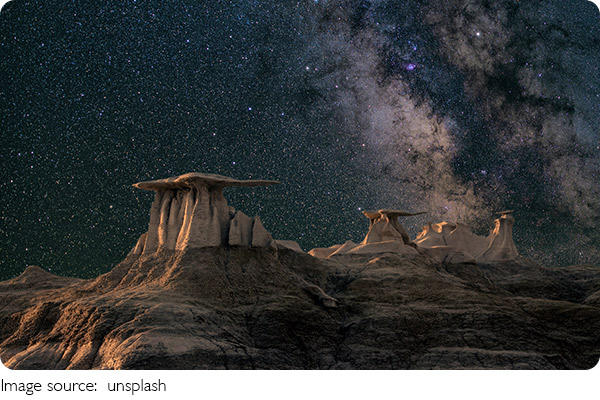Desert Starry Nights

In the desert at night, the stars appear more brilliant and clearer than they do in the city. This phenomenon is not just a subjective experience but has deep scientific reasons behind it.
The unique environment of the desert makes its night sky particularly captivating.
Let's delve into why the stars are so exceptionally clear in the desert.
1. Dry Air in the Desert
One of the most notable features of the desert is its extremely dry air. Humidity has a direct impact on the clarity of star observations. In humid areas, such as cities and wet regions, the air contains a significant amount of water vapor, which scatters light and causes the stars to appear blurry and dim.
In contrast, the air in the desert is very dry, with minimal water vapor, which greatly reduces the scattering effect of light, making the stars appear much brighter and clearer.
2. Airborne Dust and Pollution
Deserts are typically far from industrial areas and densely populated cities, which means the air is almost free from industrial pollutants and light pollution. Light pollution in cities is caused by streetlights, billboards, buildings, and other artificial light sources that scatter light.
These sources interfere with star observation, often obscuring or diluting the light of the stars due to light reflection and scattering. In the desert, the absence of these light pollution sources allows the night sky to remain naturally pure and bright.
Additionally, deserts generally have lower levels of dust in the air. Although desert winds can bring some sand and dust, overall, the air in the desert contains less particulate matter. This is another reason why stars appear exceptionally clear in the desert.
3. Atmospheric Stability
Temperature fluctuations in desert regions are often extreme, but the atmospheric stability is relatively high.
In many other areas, particularly near cities, human activities and industrial emissions lead to unstable atmospheric conditions. This instability can cause "air turbulence," with irregular temperature and density fluctuations in the air, making the stars appear to flicker or distort. The relatively dry and stable air in deserts results in less turbulence, so the light from stars is less disturbed and appears more stable and clear.
4. Absence of Urban Light Pollution
Urban light pollution comes from streetlights, vehicle lights, building illumination, and other light sources. In cities, even at night, surrounding light can interfere with star observation.
In the desert, the distance from urban areas provides a completely dark environment, which is the ideal condition for stargazing. In such an environment, the stars' light is fully displayed, allowing observers to see more stars and even the Milky Way with exceptional clarity.
5. Visual Adaptation
In the desert, the darkness of the night is very profound, which forces the human visual system to adapt.
After a period of adaptation, the eyes can better perceive faint starlight, making the stars appear brighter and clearer. This visual adaptation is a physiological process that occurs in prolonged dark environments, allowing even the faintest starlight to be detected and appreciated.

In summary, the exceptional clarity of stars in the desert is mainly due to its dry air, minimal light pollution, high atmospheric stability, and good visual adaptation. These factors combine to create an ideal stargazing environment, making the desert sky one of the most beautiful natural spectacles.
In such an environment, not only can we enjoy the beauty of the stars, but also experience the tranquility and vastness of nature. For astronomy enthusiasts and nature observers, the desert is undoubtedly a dreamlike stargazing destination.

 · Science Team
· Science Team